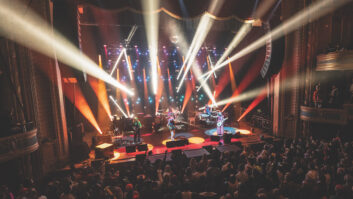If you were looking to broadcast your morning news show from a location that registers “center of the world” to millions of people around the globe, you might go shopping for a piece of Times Square real estate. That’s what the Walt Disney Company did, and the result is Times Square Studios Ltd., the new home of Good Morning America, which we recently toured in the company of the studio’s manager of engineering and technical operations, Jeffrey C. Hartnett.
Walking around the Good Morning America set, past the desks where Charles Gibson and Diane Sawyer sit, over to the bank of windows that rest just a single floor above the jangling sounds of automotive and pedestrian traffic, one is immediately struck by the silence. Each window is made with two pieces of glass, approximately an inch thick. The two panes are separated by an insulating section, and the windows weigh about 4,000 pounds each. The windows on the first floor, which houses The Subway studio, can be rolled back on those days when the crew feels like mingling directly with fans.
At this time, Times Square Studios is being used exclusively for ABC Network projects, including 20/20, but Hartnett says company strategy includes opening the facility to outside clients as well. “Times Square is the center of the known universe to some and sits at the crossroads of the world,” Hartnett says. “Ever since the Dow Jones news wire or electronic ticker was installed back in the ’40s, Times Square has been thought of as the hub to national and world events. The Ball drops in Times Square, and that’s how the nation understands the changing of the year. So, for our ABC clients, the studio provides a great location with tremendous views and great connectivity. The same would apply to third-party clients.”
The main second-floor studio, dubbed the Marquee, includes an audio control room built around a 48-fader Solid State Logic Aysis Air digital broadcast console. “The Aysis Air has the feel and look of a great traditional analog console, and many of the operators I’ve dealt with feel this is important,” Hartnett says. “But at the same time it’s a fully digital mixer with a ton of routing capability. It was designed to be used in live production and yet be so much more. It can be reset to any previous condition, and sources can be routed around internally to suit any user. To date, it has been rock-solid.”
Rock-solid performance is obviously critical when you’re broadcasting live programming to millions of people on a day-to-day basis, and all Times Square Studios purchases are based on performance in mission-critical circumstances. “We use Sennheiser wireless microphone systems,” Hartnett says. “You pay a premium for this stuff, but it pays for itself in reliability and performance. We use Vega for our RF intercoms and Lectrosonics for the wireless IFB systems. It’s all tied together into a large antenna system, which is bandpass-filtered and distributed between our two studios.
“We have a mixing/sweetening room which has its own analog mixer, a Sony DMXE-3000,” he continues. “A 24-bit Digidesign Pro Tools nonlinear editing system with Tascam DA-88, 360 Systems DigiCarts and Sony PCM-7040 DAT recorders round out the room. We have a Sony AES/EBu digital audio router, along with a Telex ADAM 256×256 matrix. This AES/EBu matrix is further broken down into audio pair levels. As you know, most of the current tape-machine formats employ four audio channels. Our routing matrix routes are in AES/EBu pairs.”
“The costs [of digital] have come down, and it’s more affordable,” Hartnett says. “The installation and checkout go more quickly since not as much time is spent in alignment. With digital you get a wide timing window, so it’s easier to test and maintain. There is a much greater variety of equipment to choose from. The science of compression and digitization is a lot further down the road, and we’re all benefiting from the results.”
Hartnett points out that Times Square Studios has “rather extensive connectivity” with ABC Network at West 66th Street, about 25 blocks uptown. Digital audio and video tielines connect both northbound and southbound. Additionally, data connections provide serial control and data streaming capability.
ABC was planning to devote more than a day’s worth of programming to end-of-the-millennium shows and will use Times Square Studios’ Sony MAV-1000 digital server extensively during production. “We also have a Sony DNE-1000 nonlinear video editing system, and we expect that ABC will begin to use this system in a regular fashion very soon.”
Although the company anticipates regularly booking sessions with outside clients in the near future, Hartnett is not prepared to hazard an opinion on the breakdown of billable hours. “I’m not so sure that assigning a percentage is appropriate just yet, but we have already started to accept work with others and have completed a few jobs which were outside of ABC.”
Next time you visit NYC, stop by 43rd Street and Broadway between 7 and 9 a.m, wave up at Charlie and Diane. But don’t bother yelling out to them, unless the windows are open.







